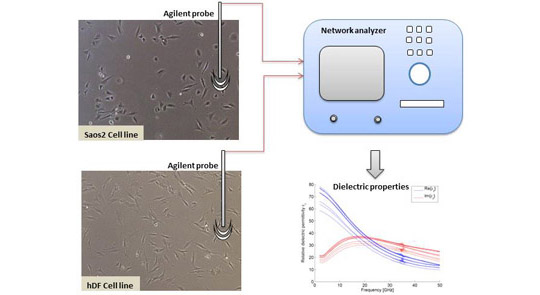
The objective of this paper was to test and evaluate an experimental procedure for providing data on the complex permittivity of different cell lines in the 2–50-GHz range at room temperature, for the purpose of future dosimetric studies. The complex permittivity measurements were performed on cells suspended in culture medium using an open-ended coaxial probe. Maxwell’s mixture equation then allows the calculation of the permittivity profiles of the cells from the difference in permittivity between the cell suspensions and pure culture medium. The open-ended coaxial probe turned out to be very sensitive to disturbances affecting the measurements, resulting in poor precision. Permittivity differences were not large in relation to the spread of the measurements and repeated measurements were performed to improve statistics. The 95% confidence intervals were computed for the arithmetic means of the measured permittivity differences in order to test the statistical significance. The results showed that for bone cells at the lowest tested concentration (33 500/ml), there were significance in the real part of the permittivity at frequencies above 30 GHz, and no significance in the imaginary part. For the second lowest concentration (67 000/ml) there was no significance at all. For a medium concentration of bone cells (135 000/ml) there was no significance in the real part, but there was significance in the imaginary part at frequencies below about 25 GHz. The cell suspension with a concentration of 1 350 000/ml had significance in the real part for both high (above 30 GHz) and low (below 15 GHz) frequencies. The imaginary part showed significance for frequencies below 25 GHz. In the case of an osteosarcoma cell line with a concentration of 2 700 000/ml, only the imaginary part showed significance, and only for frequencies below 15 GHz. For muscle cells at a concentration of 743 450/ml, there was only significance in the imaginary part for frequen- ies below 5 GHz. The experimental data indicated that the complex permittivity of the culture medium may be used for modeling of cell suspensions.
View full article

